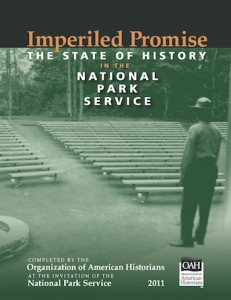A seasonal ranger ponders "The State of History in the National Park Service"
21 April 2012 – Jennifer Burns
Imperiled Promise, advocacy, education, government, profession, employment, training, new professionals, conference
 The NCPH/OAH conference brought to light a subject near to my heart this afternoon – history in the NPS. The panel consisted of Marla Miller, Gary Nash, David Thelen and Anne Mitchell Whisnant. On the docket was the discussion of their report on how the NPS stacks up in the history department. I have to admit, I haven’t read their report, Imperiled Promise. And, as a detriment to my profession, I didn’t even know it was something that was being analyzed. In considering this, however, I realize that my failure in having even heard of the study speaks directly to the findings.
The NCPH/OAH conference brought to light a subject near to my heart this afternoon – history in the NPS. The panel consisted of Marla Miller, Gary Nash, David Thelen and Anne Mitchell Whisnant. On the docket was the discussion of their report on how the NPS stacks up in the history department. I have to admit, I haven’t read their report, Imperiled Promise. And, as a detriment to my profession, I didn’t even know it was something that was being analyzed. In considering this, however, I realize that my failure in having even heard of the study speaks directly to the findings.
As it turns out, a panel of historians gave the NPS a mediocre grade when it comes to their interpretation of history, and I’m not surprised. I had found it odd, in my five seasons as an interpreter, at four different parks, that there had been a clear delineation between interpretation and history. But, how could you have one without the other? Yes, the material was there for me to research as I prepared my programs, but how was it that in my most recent position, doing only one program, a house tour (in costume, no less), I was told, in no uncertain terms, that no one had time to allow me access to archival material. At my summer home, in Shenandoah, we are introduced during training about the most recent information on climate change, emerald ash borer concerns, deer populations, and weather and air monitoring, but only an hour was devoted to an introduction of the massive amounts of research material available on a cultural level. Okay, some would say, it’s a nature park, but it also has a history that lends to the story as a whole.
The more I thought about the study, the less surprised I was to hear about the gap between interpretation and cultural resources within the park structure as a whole. The more recent push to cohesively develop themes, objectives and construct connections for visitors to take away from interpretive programs all seems moot in light of the realization that I might not yet possess all the knowledge I need to do this. When asked who was going to get this ball rolling and what would prevent this study from collecting dust on a shelf like all the others, the answer given was straightforward … you! I’m willing to take that challenge, but at what cost?
A more in-depth discussion later with some of the panel members spawned a new thought: who in the NPS was consulted on this study? It turns out I already knew the answer. Director Jon Jarvis was obviously a key component, but the others consisted of regional directors and other management level employees. The problem with that … they don’t interact with the public on a daily basis like I do. And who am I? Just another seasonal staff member who shows up on Memorial Day and leaves with end of the autumn splendor. So, I’m expected to get the ball rolling, but as I’m sure other seasonal NPS employees would agree, my voice is small and in what precarious position am I placing myself if I do push the envelope? Sure, I might create a movement, spark an epiphany, give rise to a multitude of positive comments from visitors … or, I might find that next year, when the budget of our National Parks is trimmed yet again and another influx of returning veterans is vying for the same position, that I’ll be left out in the cold. I’m going to push for an increase in more interdisciplinary work at parks and the ability for more communication across lines because my goal is to make the NPS a better and stronger unit. They are, after all, my parks, too.
~ Jennifer Burns is a seasonal ranger currently at Shenandoah National Park. She blogs at Ranger Talk. (It may be restating the obvious, but this post reflects her ideas and not those of the National Park Service.)




Jennifer, your post speaks to critical issues surrounding work hierarchies and a need for more organizational support on the front lines of interpretation. This is near and dear to my heart as well, as my work-in-progess manuscript (“The Wages of History”) analyzes these issues through an extensive case study that draws on my experience as a front line seasonal worker at a historic site in Minnesota. Let’s get the ball rolling together. We need more conversations between those with institutional power and seasonals on the front line, so those who interact most with the public can find the support and resources they need to produce critical, provoking, and nuanced interpretations of our shared history.